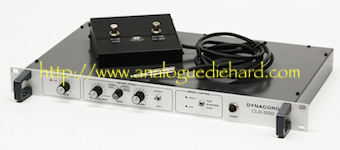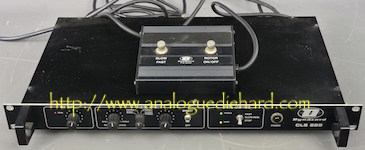Dynacord CLS-222 Leslie Simulator
Update 07-06-2024
Hammond Organs and Leslie rotating speakers have long been an
inseparable pair since the 1940s. When I was 18 years old my
first band I had started with my friends and my brother was about to
start playing bars, and I bought my Hammond Porta-B
and Leslie
760 from my piano teacher. I have been using them ever
since. The Leslie was pretty bulky and a compact simulator
would make life easier. But Hammond players are a tough crowd
with leslie simulators. Attempts were made in the past but
they fell short; some were phasers, some were chorus devices.
Not even Don Leslie, the inventor of the Leslie rotating speaker,
succeeded in designing a processor that sounded like a Leslie.
The "Leslie sound" is a complex mix of phase shifting, pitch
modulation, amplitude modulation, and frequency shifting; the
balance of modulations has to be just right, and the depth of
modulation changes between chorale (slow) and tremolo (fast)
speeds. On top of that, the top and bottom rotors have their
own set of modulations. Not an easy task, the proverbial car
that doubles as a boat.
The first good compact Hammond clone that came along was the XB-2,
which I acquired. It had an on-board leslie simulator but it
was poor so I kept using the 760. A magazine had a product
review of the CLS-222, which was very positive. And this was a
magazine that catered to keyboard players. Touring groups were
using it. But there were no local stores that carried the
Dynacord. During a business trip to Los Angeles in 1990, I
stopped in a Guitar Center store (before they became a national
chain), and they had the CLS-222 in stock. After trying it out
I immediately bought it. Since it was eight pounds and a small
1U rack format, it was easy to pack in my suitcase for the return
trip home.
The CLS-222 is the most authentic Leslie simulator I have
heard. It is 100% analog; Dynacord replaced the CLS-222 with a
MIDI capable programmable digital version called the DLS-223, but
when the magazine reviewed it they liked the sound of the old CLS
better. The CLS-222 uses an 800hz crossover (like the real
thing) to split top and bottom rotor simulators, BBD delay lines
(TDA1022s) and voltage controlled dual tandem electronic
potentiometers (TDA1074s) to emulate the Leslie animation. A
predecessor product was called the CLS-22, and not long ago I
discovered a valuable discussion from the original designer who
revealed:
- He designed it to emulate a Leslie 760 that belonged to a
friend (!)
- Clock modulation oscillators for the BBDs are designed as
voltage-controlled period generators, which yields smoother
symmetrical chorus animation.
- Amplitude modulation is quadrant dependent; IE there is less
modulation on one side to reproduce the effect of a Leslie
against a wall.
- Rotor top vs bottom are asynchronous and rotation frequencies
are different at any one speed.
- The clock modulation oscillators provide various duplicate
signals with phase offsets, for strategic destinations.
- No Leslies have flat frequency response, this was intentional
to color the sound of the organ. The CLS includes tone
shaping to emulate this.
- Ramp times between slow and fast per rotor are emulated.
- Clock sawtooth generators for the BBDs are constant slew rate
but variable level depending on rotor state. Produces a
proportional delay, rather than proportional frequency.
The variable clock oscillators are a true voltage controlled
delay (VCD).
- The CLS-22 led to the Dynacord deal resulting in the
CLS-222. The designer had no role in the CLS-222, but
there appears to be little emulation difference between the
models.
- Additions to CLS-222:
- new bypass circuit. Not true bypass as claimed.
- summing circuit for mono output.
- 4th option of stereo spread.
The CLS-222 was introduced in 1981, and for a long time it was the
only truly authentic Leslie simulator good enough for Hammond
players. It was often seen in stage racks of major touring groups. I
have never even seen an advertisement for them. Why does the
Dynacord sound so accurate? They use separate processors for
the top and bottom rotors. It's the only way to do it.
Frankly, few emulators go to this detail of emulation. The
balance of phase shifting, pitch modulation, amplitude modulation,
and frequency shifting was just right. When I played out live
using the CLS, I've had musicians come up during the break and ask
me where I was hiding the Leslie cabinet. You should see their
eyes swell when I show them the box :) One of them was a guitar
player with very discriminating ears, and he was very
impressed. It has some noise, but you can minimize it with the
right gain settings. The effect will only go out to 16Khz, but
what the hell, a real Leslie barely makes it to 16Khz
anyway!!! If you're using a guitar with it you might want
bandwidth all the way to 20Khz - subjective issue. The neat part is
that it's a stereo Leslie Simulator. You can do mono or three
modes of stereo, depending on the spread away from center.
It's ultra cool to hear those rotors whipping around the stereo PA
in a live club :) Being able to balance the top and bottom
rotor is crucial for duplicating your favorite sounds. I can
get jazz, I can get blues, I can get progressive, and I can get
rock. It won't sound like an overdriven 122 (the Neo
Ventilator II does that very well) but the CLS does the 760 very
well. Some other makers of Leslie Simulators have more parameters,
such as mic distance, ramp time between speeds, etc but the rotor
animation is not as good as the CLS-222.
Easy to use - all knobs, no menus or LCD. You can't store
settings on it. Just dial your settings and go. On the front
panel there's a power switch, input gain with overload LED, speed
switch (fast/slow/stop), rotor balance, stereo/mono mode, and output
level. There's also a pair of LEDs for the rotors, green for
the bottom and yellow for the top; these show the speed so that you
can tell at a glance whether it's in tremolo, in chorus, or
stopped. It's way cool to watch the LEDs while holding a chord
and changing speeds. On the rear there's input, mono output, stereo
outputs, fast/slow/stop footswitch, and trimpots for speed of the
rotors. No MIDI - this thing was built before those
days. Proper IEC power cord - NO WALL WARTS!!! The rear panel
also has XLR outputs, but they're not balanced outputs, they're
single ended. A waste. Early units do not have standard
IEC wiring for unbalanced outputs; mine has a sticker on the top
that says that the unit now complies with IEC wiring. If you
find an early one, don't sweat it's a simple 5-minute wiring change
inside.
The CLS-222 is the standard against which everything else is
measured. Two panels were made in different colors - dark
grey, black, and white. It was discontinued in the mid-1990s
due to component obsolesence. Only the DSP-powered Neo Ventilator
II does as good a job, and that box is designed to emulate a
Leslie 122 (including the tube distortion which the CLS did not
have).
Compact rackmount stereo analog Leslie Simulator that weighs only
eight pounds, instead of 150 in the real thing. Another friend
who is a Hammond player eventually bought one after hearing mine.
The only thing emulators will not do is emulate the three
dimensional sound of a rotating speaker in a room.
If you have a CLS-222 or are planning to acquire one, you must
remove the RIFA EMI filter at the rear of the device. These
RIFA caps have a bad reputation, and have been known to ignite in
flame when they wear out! Those RIFA filters tend to appear in
products from Europe.
If you own a Hammond-Suzuki clonewheel organ that has the 11 pin
Leslie socket (IE XK-3, XK-3c), I'll share a modification
that allows the CLS-222 rotor speeds to be controlled from the organ
using the Leslie socket. Not shown are the audio and ground
connections from the 11 pin connector. Seek the services of a
competent tech for this modification - I assume zero liability upon
any personal injury or death, or of any damage to your music gear.
I no longer have the XB-2, but I still use the CLS-222 with my Hammond
XK3. There are still times I gig with the 760, don't
want it to feel neglected :)

Home




